Archived Fire Damage Blog Posts
Thanksgiving Fire Safety: Tips for a Safe and Enjoyable Celebration | SERVPRO of Pueblo
1/7/2025 (Permalink)
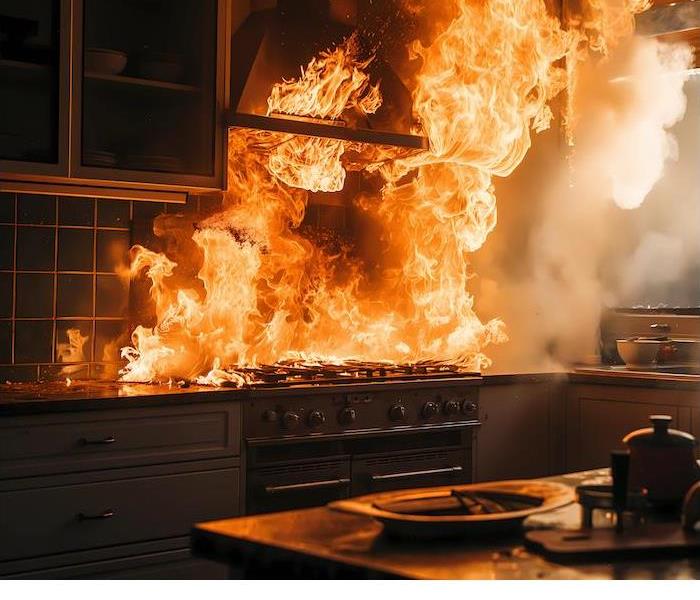 Stay safe this Thanksgiving with fire safety tips for your kitchen, including proper turkey frying!
Stay safe this Thanksgiving with fire safety tips for your kitchen, including proper turkey frying!
Thanksgiving is a time for families to gather, share gratitude, and indulge in delicious meals. However, it’s also a period when kitchen accidents can lead to fire hazards if proper precautions aren’t taken. At SERVPRO of Pueblo, we want to help you enjoy a safe and memorable Thanksgiving. Here are some essential tips for Thanksgiving fire safety, including how to deep fry a turkey without compromising your home’s safety.
Creating a Fire-Safe Kitchen EnvironmentThe kitchen is the heart of Thanksgiving festivities, but it can quickly become a hotspot for fire hazards if you’re not careful. Start by ensuring that flammable items such as dish towels, paper products, and oven mitts are kept well away from the stove and other heat sources. It’s crucial to remain vigilant while cooking; never leave your stove unattended, especially when using oil or open flames. If you must step away, even for a moment, turn off the heat to prevent any potential accidents.
Another important safety measure is to have a fire extinguisher easily accessible in the kitchen. Familiarize everyone in your household with its location and usage. Understanding how to operate the extinguisher can make a critical difference in case of an emergency. Regularly check that your fire alarms are working and have fresh batteries. This ensures that you’re alerted promptly in the event of smoke or fire, giving you the best chance to respond quickly.
Safe Turkey Deep Frying TechniquesDeep frying a turkey has gained popularity for producing crispy, delicious results, but it’s vital to approach this method with caution. Always set up your deep fryer outdoors, at least 10 feet away from your home, garages, and overhanging branches. Choose a flat, stable surface to avoid spills or tipping. Before you heat the oil, ensure your turkey is completely thawed and dry. Water and hot oil don’t mix; introducing moisture can cause the oil to splatter and create a fire hazard.
Monitor the oil temperature closely, and never leave the fryer unattended. If you find yourself distracted, ask a family member to keep an eye on it. In the unfortunate event that a fire breaks out, use a fire extinguisher specifically designed for grease fires. Do not use water to extinguish a grease fire, as it can cause the flames to spread. Instead, turn off the heat and cover the pot with a lid if safe to do so, or use the fire extinguisher.
Ensuring Safety After the MealOnce the Thanksgiving feast is over, it’s essential to maintain safety as the celebration winds down. Make sure all cooking appliances are turned off, and never leave leftovers out at room temperature for more than two hours. Properly refrigerate leftovers to prevent foodborne illnesses and keep your kitchen safe. When disposing of used cooking oil, do so responsibly. Allow the oil to cool completely before transferring it to a sealed container for disposal.
As you clean up, avoid the temptation to leave hot pots or pans unattended. Let them cool completely before cleaning or storing them. This practice not only helps prevent burns but also minimizes the risk of fire hazards. Lastly, remind everyone in the household to remain vigilant and report any unusual smells or signs of smoke.
Thanksgiving is a time to celebrate with family and friends, but safety should always come first. By following these Thanksgiving fire safety tips, including safe methods for deep frying a turkey, you can ensure a joyful and worry-free holiday. If you experience a fire in your home, remember that SERVPRO of Pueblo is ready to assist with fire damage restoration and cleanup. We wish you a safe and happy Thanksgiving!
For more information on fire safety and our restoration services, don’t hesitate to contact us today. Your safety is our priority, and we’re here to help® you protect your home.
Tips to Protect Your House During Wildfire Season | SERVPRO of Pueblo
10/17/2024 (Permalink)
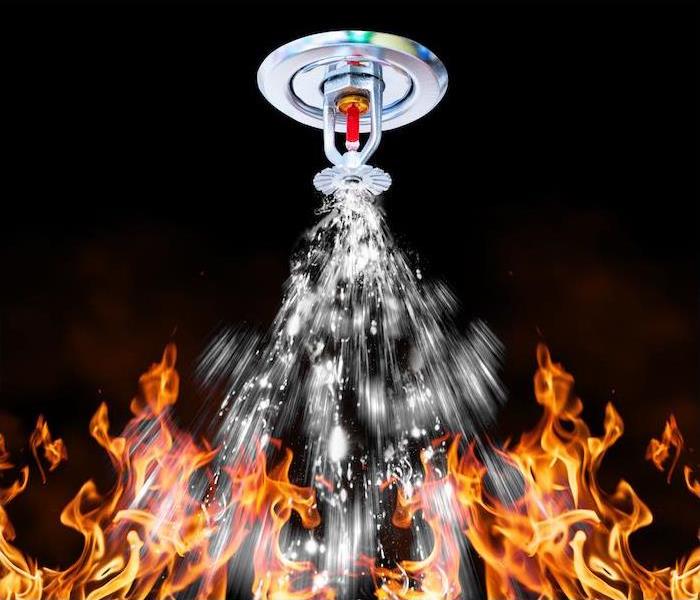 Protect your business with a safety plan! Contact SERVPRO® for expert guidance on fire prevention and ensure your employees and property stay safe.
Protect your business with a safety plan! Contact SERVPRO® for expert guidance on fire prevention and ensure your employees and property stay safe.
Wildfire season poses a serious threat to homes, especially in areas prone to dry conditions and high winds. The risk of a wildfire spreading to residential areas underscores the importance of taking proactive measures to protect your property.
At SERVPRO of Pueblo, we understand the urgency of safeguarding your home from the devastating effects of wildfires. Here are some essential tips to help you prepare and protect your house during wildfire season.
Create a Defensible Space Around Your HomeOne of the most effective ways to protect your home from wildfires is to create a defensible space around it. This involves clearing flammable materials and vegetation that could act as fuel for a fire. Start by maintaining a safe distance between your home and any trees, shrubs, or grass. Trim branches that hang close to your house and remove dead leaves and other debris from gutters and roof areas.
Additionally, consider using fire-resistant plants and landscaping materials in your garden. By creating a defensible space, you reduce the likelihood of a fire reaching your home and give firefighters a better chance to defend your property if necessary.
Fortify Your Home’s ExteriorStrengthening the exterior of your home can significantly enhance its resilience against wildfires. Start by ensuring that your roof is made of non-flammable materials such as metal or asphalt shingles, and keep it free of leaves and other debris. Install metal or fiberglass mesh screens on vents and openings to prevent embers from entering your home.
Ensure that windows and doors are tightly sealed and consider using tempered glass or fire-resistant materials to further protect these vulnerable areas. Regularly inspect and maintain these features to ensure they are in good condition and capable of withstanding a wildfire.
Develop a Wildfire Preparedness PlanIn addition to physical measures, having a comprehensive wildfire preparedness plan is crucial. Develop an evacuation plan that includes multiple routes out of your area and establish a communication strategy with family members to ensure everyone knows what to do in the event of an evacuation. Prepare an emergency kit with essential items such as medications, important documents, and basic supplies that you can quickly grab if you need to leave your home.
Make sure to stay informed about local fire alerts and conditions by signing up for emergency notifications and monitoring local news. A well-thought-out preparedness plan ensures that you and your family are ready to respond swiftly and safely in case of a wildfire.
Protecting your home during wildfire season requires a combination of proactive measures and preparedness. By creating a defensible space, fortifying your home’s exterior, and developing a comprehensive preparedness plan, you can significantly reduce the risk of damage and ensure the safety of your property and loved ones.
At SERVPRO of Pueblo, we are dedicated to helping you protect your home and respond effectively to any emergencies. If you need assistance with wildfire preparation or have any concerns about the safety of your property, contact us today. Let us help you safeguard your home and give you peace of mind during wildfire season.
Reach out now to learn more about our services and how we can support you in protecting your home.
Winter Fire Safety: Protect Your Home with These Essential Tips | SERVPRO of Pueblo
9/4/2024 (Permalink)
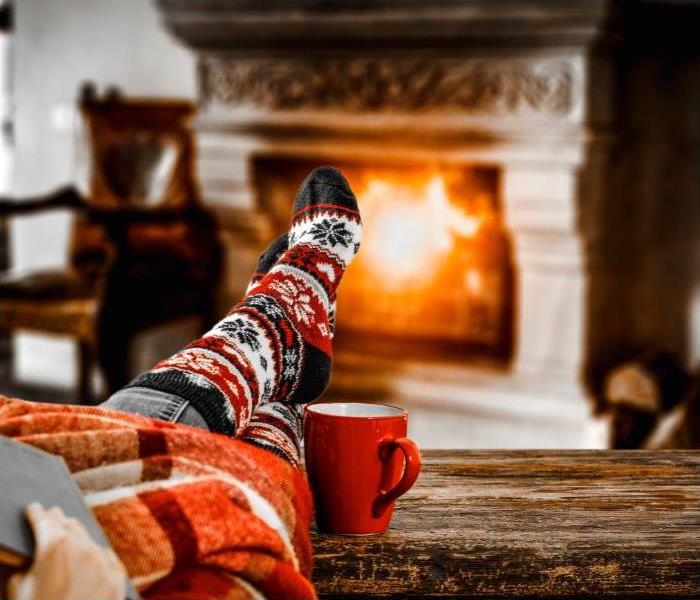 Keep your home safe this winter with these helpful fire safety tips from SERVPRO of Pueblo!
Keep your home safe this winter with these helpful fire safety tips from SERVPRO of Pueblo!
As winter settles in, the increased use of heating systems, holiday decorations, and space heaters can elevate the risk of a home fire. Understanding and implementing fire safety measures is crucial to keeping your home and family safe during the colder months.
Read on for essential tips to protect your home and ensure a safe and warm winter season.
Prepare Your Heating Systems
As winter approaches, it's crucial to ensure your heating systems are safe and efficient to reduce the risk of a home fire. Start by having a professional inspect and service your furnace or heating system before you use it for the first time each season. Regular maintenance can help identify and address potential issues, such as faulty wiring or gas leaks, that could lead to a fire.
Additionally, clean and inspect your chimney and flue if you use a fireplace or wood stove. Creosote buildup in chimneys is a leading cause of chimney fires. Make sure to have these systems professionally cleaned to prevent dangerous fires. Taking these steps helps ensure that your heating systems operate safely and efficiently throughout the winter.
Practice Fire Safety with Holiday Decorations
Winter months, especially the holiday season, often involve the use of festive decorations that can increase the risk of a home fire if not managed properly. When decorating with lights, ensure that you use only those that are rated for indoor use and check for any frayed or damaged wires before hanging them up.
Overloading electrical outlets can lead to overheating and potential fires, so avoid plugging too many devices into a single outlet. Additionally, keep all decorations, including trees, away from heat sources such as radiators and space heaters. Real trees should be watered regularly to prevent them from drying out, as dry trees are highly flammable. By practicing these fire safety tips, you can enjoy a festive season without compromising your home's safety.
Ensure Safe Use of Space Heaters and Fireplaces
Space heaters and fireplaces are commonly used during the winter months for additional warmth, but they also pose significant fire risks if not used correctly. Always place space heaters on a flat, non-flammable surface and keep them at least three feet away from any combustible materials such as curtains, furniture, or bedding.
Never leave space heaters unattended, and turn them off when you leave the room or go to sleep. For fireplaces, use a fireplace screen to prevent embers from escaping and ensure that you only burn seasoned wood to reduce the amount of creosote buildup in the chimney. Additionally, make sure that your smoke alarms are functional and have fresh batteries. Regularly testing and maintaining your smoke alarms can provide an early warning in case a fire does occur, giving you valuable time to respond.
Winter is a time when fire risks can increase due to the use of heating systems, holiday decorations, and space heaters. By taking preventive measures and practicing fire safety, you can significantly reduce the risk of a home fire. If a fire does occur despite your best efforts, SERVPRO of Pueblo is Here to Help® with professional fire damage restoration services.
For immediate assistance and expert guidance, contact SERVPRO of Pueblo today. Protect your home and family this winter by following these safety tips and knowing that help is just a call away.
Top 5 Leading Causes of Residential Fires in Pueblo, CO
10/19/2023 (Permalink)
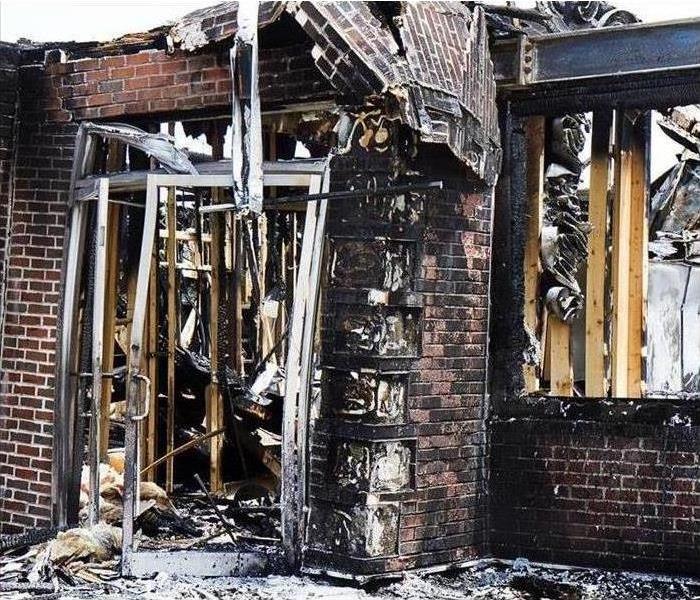 Severely fire damaged home in Pueblo, CO.
Severely fire damaged home in Pueblo, CO.
Residential fires can be devastating, causing loss of life, property damage, and emotional trauma. Pueblo, Colorado, with its unique blend of urban and rural communities, faces its own set of challenges when it comes to fire safety. Understanding the leading causes of residential fires is crucial for both homeowners and local authorities. In this blog, we'll explore the top 5 leading causes of residential fires in Pueblo, Colorado, and discuss how to prevent and protect against these potentially deadly incidents.
Top Five Leading Causes of Residential Fires
- Cooking-Related Fires
Cooking is an essential part of daily life, but it's also one of the most common causes of residential fires in Pueblo and across the United States. Unattended stoves, hot oil, grease fires, and flammable objects near cooking appliances can lead to dangerous situations. In Pueblo, where many households take pride in their culinary skills, the risk is even higher. To prevent cooking-related fires:
- Stay in the kitchen when cooking and never leave food unattended.
- Keep flammable items, like towels or curtains, away from the stovetop.
- Use a timer to remind you of food on the stove or in the oven.
- Install a fire extinguisher in the kitchen and know how to use it.
- Electrical Fires
Faulty electrical systems and overloaded circuits are another common cause of residential fires in Pueblo. Older homes with outdated wiring are particularly susceptible, and the use of modern electronic devices and appliances has increased the risk of electrical fires. To reduce this risk:
- Have your electrical system inspected regularly by a qualified electrician.
- Avoid overloading outlets with too many devices and use surge protectors.
- Replace damaged or frayed cords and wires promptly.
- Upgrade your home's electrical system if it's outdated or not up to code.
- Heating Equipment Fires
In Pueblo, where cold winters are not uncommon, heating equipment plays a crucial role in keeping homes warm. However, heating equipment can also be a significant cause of residential fires, particularly when not properly maintained or used. Wood stoves, space heaters, and furnaces are potential hazards. To prevent heating equipment fires:
- Have heating systems and chimneys inspected and cleaned annually.
- Maintain a safe clearance between space heaters and flammable materials.
- Use screens or doors with wood stoves to prevent sparks from escaping.
- Install smoke detectors and carbon monoxide detectors in your home.
- Smoking-Related Fires
Smoking-related fires are a leading cause of residential fires in Pueblo. Cigarettes, cigars, and other smoking materials, when not disposed of properly, can ignite fires. Moreover, smoking indoors can lead to fire risks, particularly if a smoker falls asleep or becomes careless. To reduce the risk of smoking-related fires:
- Smoke outside the house and use a sturdy, deep ashtray.
- Never smoke in bed or on a couch, as it's easy to fall asleep with a lit cigarette.
- Keep lighters, matches, and smoking materials out of the reach of children.
- Consider quitting smoking for your health and safety.
- Candles
Candles are commonly used for ambiance, relaxation, and religious purposes. However, they pose a fire risk, especially when left unattended or placed near flammable materials. In Pueblo, where the charm of candlelit dinners or prayer is appreciated, it's crucial to use candles safely:
- Always keep candles on a stable, heat-resistant surface.
- Never leave candles burning when you leave a room or go to sleep.
- Use candle holders that can catch dripping wax.
- Consider using flameless LED candles as a safer alternative.
Preventing Residential Fires in Pueblo
In addition to understanding the leading causes of residential fires, there are several proactive steps you can take to minimize the risk and protect your home and loved ones in Pueblo:
Install Smoke Alarms: Ensure that you have working smoke alarms on every level of your home and inside each bedroom. Test them regularly and replace batteries as needed.
Create an Escape Plan: Develop and practice a fire escape plan with your family, including a designated meeting point outside the home. Make sure everyone knows how to escape safely.
Install Carbon Monoxide Detectors: Carbon monoxide is an odorless, colorless gas that can be deadly. Install carbon monoxide detectors to alert you to its presence.
Store Flammable Items Safely: Keep flammable materials, such as gasoline, propane, and paints, stored in a well-ventilated area away from heat sources.
Know How to Use Fire Extinguishers: Make sure you have fire extinguishers in key areas of your home and that you know how to use them in case of a fire.
Regular Home Maintenance: Keep your home in good repair by maintaining electrical systems, heating equipment, and fireplaces.
Residential fires can be devastating, but understanding the leading causes and taking preventive measures can significantly reduce the risk. Pueblo, Colorado, like any other community, faces its unique fire safety challenges, and the responsibility lies with both homeowners and local authorities to ensure the safety of residents. By being aware of the top causes of residential fires and implementing preventative measures, you can protect your home, loved ones, and your community from these potentially deadly incidents. Fire safety should always be a top priority, not only in Pueblo but everywhere.
7 Ways To Reduce Kitchen Fire Risk While Cooking
8/4/2023 (Permalink)
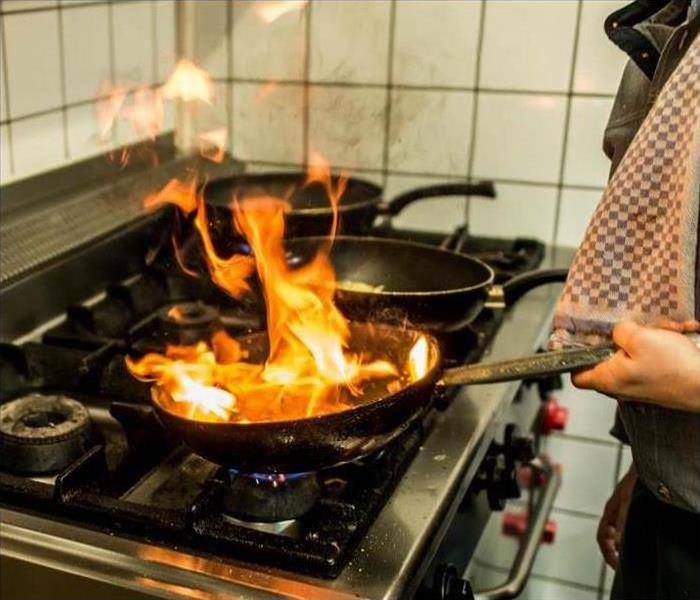 Follow These Tips to Reduce Kitchen Fire Risk While Cooking in your Pueblo, CO property.
Follow These Tips to Reduce Kitchen Fire Risk While Cooking in your Pueblo, CO property.
After a long day, kitchen safety may not be at the top of your mind. You just want to prepare a meal, sit down and eat. However, most residential fires begin in the kitchen. Fortunately, there are some simple tips for significantly reducing your risk of a cooking fire at your home in Pueblo, CO.
Limit Your Risk of Fire but Be Prepared for Fire Damage
- Watch Cooking Food
One of the most essential kitchen fire safety measures is to stay in the area while food is cooking. A fire can begin in mere seconds, which means it could become out of control before you even realize something is burning. If you need to leave the kitchen, recruit someone to watch it.
- Have a Fire Extinguisher Within Reach
It's always helpful to keep a fire extinguisher within reach in case something bursts into flames. Extinguishing the fire within seconds can mean the difference between minor to no damage and total devastation. Also, make sure everyone knows how to operate the fire extinguisher properly.
- Learn the Proper Fire Extinguishing Techniques
No two fires are alike. Some methods of extinguishing a specific kind of fire can actually make another type of fire worse. Keeping a pan lid over a fire will typically extinguish it. One of the most important tips to remember is to NEVER put water on a kitchen fire, particularly a grease fire, as it can make it spread fast and harm you in the process.
- Be Careful With Hot Grease
Grease fires can be the most hazardous type of kitchen fire. Cooking oils can present significant hazards if used at temperatures above their smoke point. These oils begin smoking at different temperatures, so it's essential to be aware of the line and not cross it when cooking.
Also, don't let the hot oil and grease near flammable materials (including trash in your trash can) until they are completely cooled.
- Keep Emergency Phone Numbers Close
There's always somewhat of a risk that a fire could break out in your kitchen, so just as you keep a fire extinguisher close by just in case, it's also good to have emergency phone numbers within reach. Post any numbers you may need in case of an emergency in the kitchen for the whole family. These numbers include the direct numbers for your fire and police departments, as well as the numbers for fire damage restoration professionals and friends and family who should be notified.
- Maintain Your Smoke Detectors
Many people forget or avoid maintaining their smoke alarm system. If something starts smoking or a blaze begins, a well-maintained smoke detector will quickly alert you. The most important thing is to replace each unit's batteries at least twice a year and test the devices to ensure they're working correctly. You also need to keep them clean and dust-free.
- Be Mindful of Flammable Materials Nearby
While you're cooking, it's essential to remain mindful of flammable materials near hot appliances and food. Keep long sleeves rolled up, and don't wear baggy clothes while cooking. Also, be aware of towels, curtains, papers and other combustible materials such as aerosol cans and lighters.
A fire in your kitchen can get out of control quickly. Keep your family and home safe by following these tips for cooking safely.
Creating a Fire Escape Plan for Your Home
6/24/2022 (Permalink)
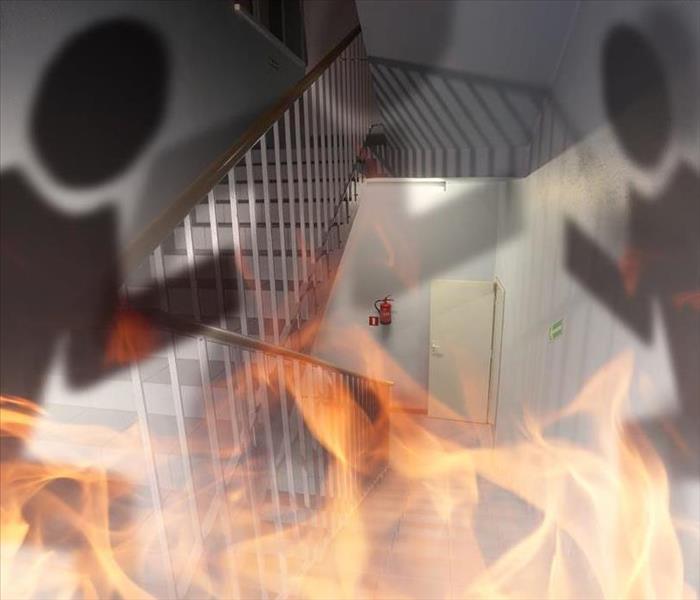 Create the best Fire Escape Plan following the Tips of our Professionals.
Create the best Fire Escape Plan following the Tips of our Professionals.
While no one hopes to experience a fire in their home, it’s important to be prepared ahead of time. From carrying homeowners’ insurance to knowing which local fire restoration company to call, you need to have a plan that outlines what to do in the event of a fire. If your home in Pueblo, CO, catches fire while you and other household members are there, do you have a plan for a safe exit? Now’s the perfect time to come up with a fire escape plan. Here’s what you need to know.
Developing a Fire Escape Plan
Creating an escape plan should be done collaboratively with everyone in the household, including children. Consider the following tips:
- Walk through the home making note of all possible exits from the house, including doors and windows.
- Your plan should also account for exiting the home from upper floors.
- Create a map of the home with exits and smoke alarms for young children.
- Make sure your routes for escape are clear and free of obstacles.
- Confirm that doors and windows are easy to open.
- Determine an outdoor meeting place that everyone will head to. It should be a safe distance from your house and marked on your map.
- Your plan should designate an official assistant for helping infants, the elderly, and anyone with limited mobility escape. Indicate a backup in the event the first designee is not home during a real emergency.
Coming up with a plan allows you to take stock of any changes that need to be made to help everyone exit the building quickly and safely.
Testing Your Plan
Practice makes perfect, and you’ll need to test your plan to see if it’s effective. Consider these tips for testing your fire escape plan: Practice your fire plan at different times of the day, including the nighttime. Commit to fully exiting the building, making accommodations for those whose mobility is limited.
While you don’t want to frighten young children, it’s important to test your plan when they’re asleep. This lets you know if your smoke alarms are effective at waking them up. Your escape plan may need to designate someone responsible for waking them up.
Test alternate escapes
In a real home fire, the quickest route may not be the safest. Everyone should practice getting low to simulate crawling under smoke. Keep ladders near windows for safe exits from the second floor.
Planning for No Escape
Your fire preparation plan should also account for a situation where home escape isn’t possible. Fire or smoke may block all exits. Come up with a plan for isolating family members from fire or smoke. This includes closing doors, sealing openings, and covering vents to limit the spread of fire and smoke. Household members should also know how to open windows to let in fresh air. Be sure to include flashlights or other devices to direct firefighters to your location.
As a responsible homeowner, you want to make sure you and your household are prepared for a fire. A well-developed and practiced fire escape plan is your best chance for survival. Accidents can happen at any time of the day, so it’s important to practice executing your plan at various times and under different circumstances.
4 Critical Kids Safety Lessons for Escaping a House Fire
3/16/2022 (Permalink)
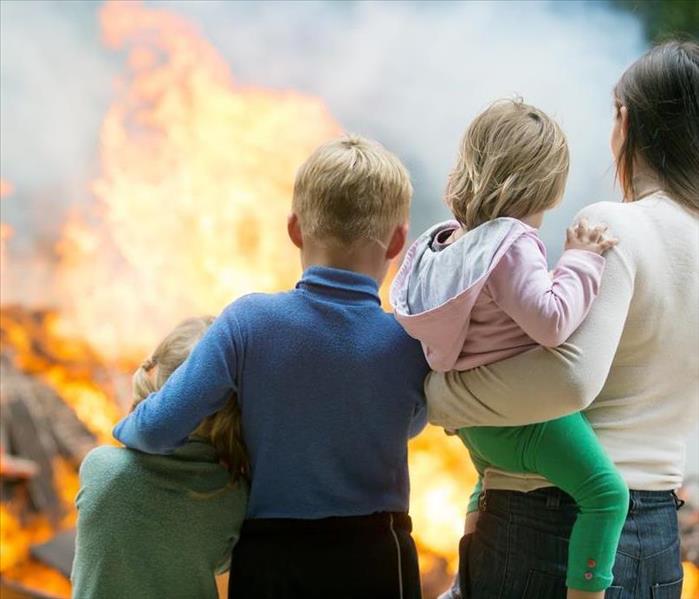 Learn more about How To Escape from a House Fire by following These Tips.
Learn more about How To Escape from a House Fire by following These Tips.
The National Fire Protection Agency notes that approximately 26% of blazes happen within a residential structure. These events are often sudden and quick, leaving little time to locate each other and discuss options. In addition, the situation proves trying for the youngest with Stanford Children's Health citing that almost 500 kids 14 and young die from the conflagration each year. Kids safety is essential and on the line.
How can homeowners safeguard their loved ones from harm?
Many adults likely remember cherished lessons of fire safety within schools. That information should also occur within the home. Parents can make a difference by taking a proactive approach to educating their little ones. The following are four critical survival tips to work on as a family.
1. Plan Out Kids Safety Efforts
Parents in Pueblo, CO, should sit down with their youth, creating a viable escape plan. Even little kiddos must know how to react since flare-ups could separate members. In addition, working through the big picture together allows adults to answer and clarify questions; plus, it minimizes the chance of confusion.
Discuss escape routes. Pick out several, drawing a map for your children to see. Walk through the paths, explaining that no one should go back inside or deviate from the designated walkway. Don't wait for others. Instead, plan a spot to meet up outside. Once there, adults can call authorities, insurance and a local fire remediation team.
Practice this plan frequently to ensure everyone remains on the same page.
2. Explain the Value of Smoke Detectors
When the alarm goes off at school, kids know the drill. Line up and leave. During a home fire, children should listen and react to smoke detectors. Show the device, and talk about how it works. The residence should have them throughout the property. When it notices smoke is in the building, the unit emits a loud sound, signaling a warning. Be sure that kids follow the family's escape guide if they hear the noise.
3. Review How To Handle Smoke and Heat
While some safety departures may occur with clear air and ease, others involve kids moving through smoke and increased temperatures. These changes require specific measures. Teach your children about how smoke moves to higher ground, so it's best to remain as low as possible. Show them specific positions such as crawls on the stomach or knees to protect them from excess smoke.
During a fire escape, little ones should avoid relying on their eyes. Instead, they need to feel around the room, checking door handles for excess heat. Consider playing a blindfold game, allowing your loved ones to move about the room, learning to find their way out without their eyesight. At times, alert them to hot doors and ask them to find another possible exit.
4. Open Windows, and Try Out Ladders
If a blaze blocks an exit, youth must adjust. Try out window escapes. Can you kids open it up? Do they know how to find the ladder or make a white signal flag for location? Pick days to run through these drills.
When a residential fire strikes, it's imperative that young ones know how to react. Adults can prepare them for these nerving times by putting kids safety first and setting aside time to talk about escape plans and have practice drills.
Kids Safety: Fire Escape Plans
1/6/2022 (Permalink)
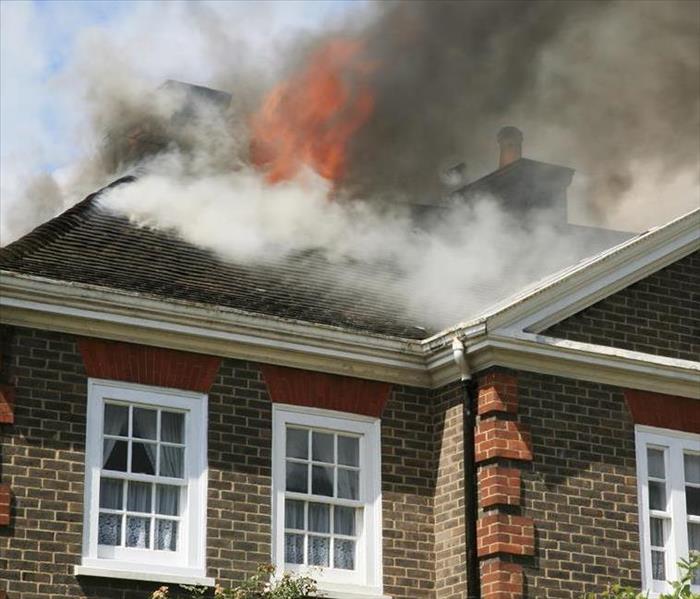 Follow these advices to create a good Fire Escape Plan for your family. Someday these tips could save lives.
Follow these advices to create a good Fire Escape Plan for your family. Someday these tips could save lives.
What does every parenting book on the planet stress the importance of? Kids safety. However, aside from maintaining doctor appointments and learning practical first aid, how many parents reach beyond to learn and interject more safety protocols into their children's lives?
Many parents instinctively act in their child's best interest, which is excellent. However, what does that teach the child, especially in terms of emergencies like fires?
Advices that might be vital in case of Fire Escape
Many families do not see house fires as realistic threats, but they are; just ask any restoration service in Pueblo, CO. Teaching children escape strategies through repetition and exercises is the best way to keep the family safe. Learning to protect themselves can also serve as a psychological boost as it:
- Improves confidence
- Incorporates decision-making skills
- Reduces anxiety
Kids Safety: Fire Escape Training
While intuition can play a role in safety, it should not become the sole influence. The body's fight or flight response is not always dependable and can lead to greater risks of injury in disaster situations. Instead, parents should help their children create, incorporate, and practice real-world strategies for escape during fires. These plans should include several exit routes and the elimination of obstacles.
Additionally, a plan is only as effective as its practice runs. During a disaster or crisis, people panic. Unfortunately, panic can lead to indecision. Repetition can reduce the risk of a panic-induced freeze, helping your entire family get to safety.
Specific Objectives
A home fire is dangerous, but knowing how to design and implement an escape plan can reduce the risk of serious injury. A plan should focus on multiple exits and the elimination of obstacles.
Every room in your home should have a minimum of two exits. A bedroom, for instance, will have a window and a door. When creating your family escape plan, your job is to identify these exits and teach your children.
Additionally, your escape path out of each room or area of the home needs to be clear. Smoke is thick and hard to see through; you do not want to run into a bookshelf, table, or another item while trying to make a quick escape.
Importance of Repetition
Because of the potential for low visibility and the threat of panic-induced freezing, you should practice your escape routes several times throughout the year. A good rule of thumb is to practice at least once every six months. However, you might want to practice monthly with little ones.
By practicing, you are essentially creating muscle memory and eliminating the need for too much thinking during a fire. It is the confusion and overthinking that will lead to extensive injuries.
Kids safety depends on preparation and commitment, and each is up to the parents. The younger you start teaching your children about escape plans and fire safety, the easier it will be to instill good habits. You can talk to the local fire department or a fire mitigation specialist to determine the best escape routes through your home and learn other fire safety tips and tricks. However, it would be best to remember to practice what you learned.
Avoiding Holiday Hazards
12/20/2021 (Permalink)
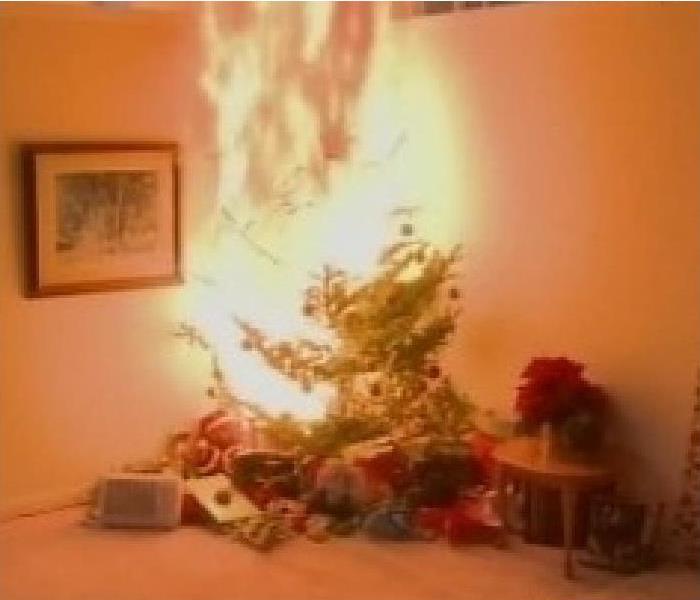 Consider these preventions tips in the holidays to avoid any type of fire damage.
Consider these preventions tips in the holidays to avoid any type of fire damage.
Pretty lights and decorations add to the feel of the holiday season, but if they are not used properly your holidays can quickly go from festive to frightening. Fortunately, by following a few simple safety tips, you can greatly reduce the fire risk in your Pueblo, CO home, this holiday season.
Tips To Avoid a Fire in Holidays
Candle Safety
Candles are widely used throughout the holidays, and December is the peak month for home candle fires. The National Fire Protection Association's (NFPA) statistics show, more than half of all candle fires start because the candles were too close to flammable objects. Consider using flameless candles instead of real candles, keep them at least 12 inches from anything flammable, and remember to extinguish them when leaving a room or going to bed. Use sturdy candle holders that are not likely to tip over and place candles on clear, uncluttered surfaces.
Christmas Tree Safety
The NFPA also reports local fire departments to respond to an average of 250 Christmas tree-related fires each year, with the majority of these fires caused by electrical problems.
If you have an artificial tree, be sure it is labeled, certified, or identified by the manufacturer as a fire retardant. If you choose a live tree, pick a tree with fresh, green needles that do not fall off when touched, and make sure the tree has plenty of water every day.
Make sure the tree is at least three feet away from any heat source, like fireplaces, radiators, candles, heat vents, or lights. The tree should also be clear of all exits. After the holidays, properly dispose of your tree. Dried-out trees can be a fire hazard and should not be left in the home or garage, or placed outside the home.
Decorative Lights
When purchasing decorative lights, make sure they are properly labeled and have been inspected by an independent testing laboratory. It is also important to ensure you have the correct type of lights; some lights are designed for only indoor or outdoor use, but not both. Carefully inspect light strands before placing them. Replace any string of lights with worn or broken cords or loose bulb connections.
Connect no more than the number of light strings recommended by the manufacturer. Remember to turn off outside decorative lights and Christmas tree lights before leaving or going to bed.
Your local SERVPRO OF PUEBLO wishes you a safe and happy holiday season!
Ways You Can Protect Your Business From Fire
11/10/2021 (Permalink)
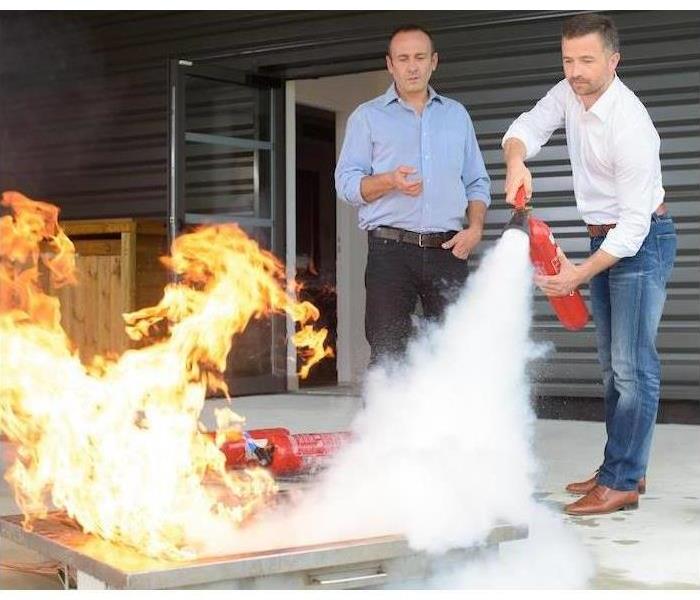 Take some prevention steps to avoid further damage in your Pueblo, CO business.
Take some prevention steps to avoid further damage in your Pueblo, CO business.
When you own a business, you must take safety precautions for your business, employees, and visitors. One of the things you need to consider and spend a little extra time planning for and working toward is fire prevention.
The National Fire Protection Association (NFPA) reports that the leading causes of structure fires in office properties from 2007–2011 were (in order):
- Cooking equipment
- Electrical distribution and lighting equipment
- Heating equipment
- Intentional
- Smoking materials
- Exposure
- Electronic, office, or entertainment equipment
Of those causes, intentional, exposure, and electrical distribution, and lighting equipment accounted for the most property damage with 20%, 18%, and 15% respectively.
In 2007, the Bureau of Labor Statistics found that fires and explosions accounted for 3% of all workplace fatalities.
In studying more recent numbers, the NFPA estimates that during the period from 2007–2011, U.S. fire departments responded to an average of 3,340 fires involving office properties per year. Those were responsible for an annual average of four deaths, 44 injuries, and $112 million in direct property damage.
You Can Protect Your Business
So what are some of the many steps you can take to protect your business? By focusing on fire risk assessment, fire prevention, and staff education, you will be working to reduce the chance of a fire breaking out.
Make an Assessment of Any Fire Hazard Risks in Your Facility.
In some locations, your local government may have a fire marshal who can visit your establishment to help identify these risks and provide guidance.
Right Fire Protection Equipment.
This includes an automatic sprinkler system, smoke detectors, and fire extinguishers on each floor.
Fire Plan
Most importantly, consider your employees and visitors. Creating a plan and reviewing it with your staff will ensure everyone knows what to do in the event of a fire. Conduct fire drills at least once a year to keep that safety protocol fresh in their minds, and take time to review evacuation plans and the location of first-aid kits.
Despite best efforts and safety tips, the worst could always happen at your business in Pueblo, CO. If a fire has damaged your business, SERVPRO is available to help make it "Like it never even happened."
Steps of the Fire Damage Mitigation Process
10/22/2021 (Permalink)
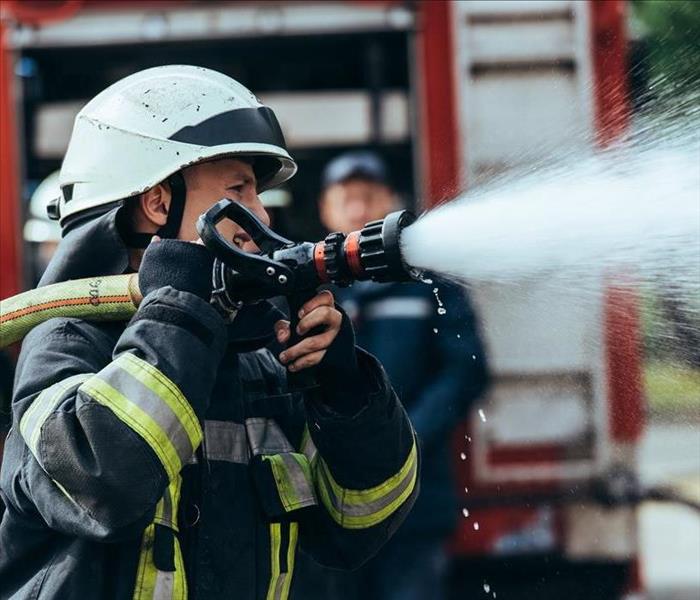 Call a restoration team to repair your home after a fire in Pueblo, CO.
Call a restoration team to repair your home after a fire in Pueblo, CO.
The flames in a house fire can destroy a lot of your home in Pueblo, CO, in a very short amount of time. Important documents, furniture, clothing, and even the structure itself are likely to sustain fire damage. To further complicate matters, the water that firefighters use to put out the fire can also destroy parts of your home. Full mitigation involves addressing both types of damage to make your house whole again.
Steps That Fire Restoration Specialists Must Take.
Assess Fire Damage
When the cleanup team arrives, the first action step is to map out the rest of the process. The members of the team look at several factors:
- The extent of the damage
- Size of the affected area
- Time passed since the fire
- Number of belongings involved
All of these factors impact not only how much work needs to be done but also the timeline for completing it. This information, in turn, dictates how much the cleanup process is likely to cost. You may not be able to control all the factors, but the sooner you call for help, the more likely it is that technicians will be able to stop ongoing damage in its tracks.
Remove Excess Moisture
To take care of the water damage, all standing water must be removed from your house. This step occurs early in the process to help prevent secondary damage such as rot or mold growth. After industrial pumps extract water and debris, technicians can get a better look at the problems they left behind.
Tear Out Ruined Materials
No matter how quickly the flames are put out, they still leave behind quite a bit of fire damage. All ruined materials, including flooring, ceiling, walls, insulation, roof materials, and support beams, must be torn out. Technicians conduct this process methodically so that they don't compromise more of the structural integrity of the house.
Clean and Dry Remaining Structure
Once the water from the fire hose hits the flames and the burning structure, it is contaminated, which means everything that it touches must be disinfected. The mitigation team cleans the remaining parts of the house, getting rid of bacteria as well as soot and smoke damage. Then the entire space must be dried thoroughly.
Determine Salvageability of Belongings
Items that were removed along with ruined materials meet one of two fates. They are either cleaned so that they can be returned to your home, or they are discarded. Remediation experts have the training and experience not only to determine which items can be salvaged but also to clean them properly so that they are safe to use.
Restore Home
The final step of the mitigation process is restoring your home to its former glory. The technicians rebuild the structure and make sure the tile, paint, and wallpaper all have seamless finishes. The job isn't finished until your house is ready for you to move back in.
Taking care of the fire damage to your home is just one part of the restoration process. Understanding the importance of each step helps you set clear expectations for cleanup.
Fall and Fire Risk: What You Should Know | SERVPRO® of Pueblo
9/21/2021 (Permalink)
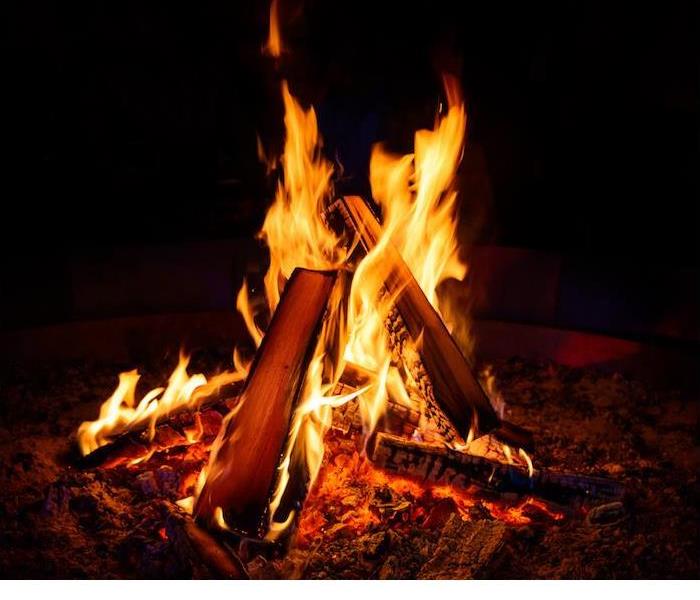 Be mindful about fall fire safety. Always remember that SERVPRO of Pueblo is the trusted leader in the restoration industry.
Be mindful about fall fire safety. Always remember that SERVPRO of Pueblo is the trusted leader in the restoration industry.
While we still have a ways to go, the evenings are starting to bring about the crisp fall air. Fall is a favorite, especially in our neck of the woods. Hiking, camping and other outdoor activities become much more enjoyable.
Like any other season, though, fall brings dangers or hazards that we need a gentle reminder about. So, as you put on your warm slippers at the end of the day, take a quick glance at these seasonal safety tips.
Campfire Safety
Campfires can be the perfect ambiance to any activity, but it’s essential to know where and how to build it, as well as how to put it out. When you are prepping to start a campfire, you should be sure to use dry leaves, twigs or branches.
When you are ready to start the fire, it’s best to use a match or lighter, and never use an accelerant like kerosene or lighter fluid. A good thing to remember is to keep a safe distance between your campfire and anything else that can easily catch fire.
And last but not least, before heading in for the night, make certain that you have extinguished your fire completely before leaving the fire. You can always (slowly) douse your fire with water to ensure that the embers are completely drenched.
Space Heaters
As we know, here in Pueblo it can easily go from crisp air to quite chilly. This is when a space heater can become quite handy.
Portable space heaters, while handy, are also one of the most frequent causes of home fires. Anytime you use a space heater, it’s imperative that you keep it up and away from anything flammable.
Nowadays, many space heaters come with an automatic shutoff capability, which ensures that if your space heater overheats or falls over it will automatically shut off. This reduces the risk of fire tremendously. While this feature can be very helpful, it’s also smart to make sure you keep the space heater up and away from kids or high traffic areas.
Halloween
While it’s still a few weeks away, we all know that a lot of us look forward to decorating our homes or porches for the fall season.
We’ll go into depth about specific holidays later, but be aware that all decor and costumes can cause a serious fire hazard. It’s important to stay aware and attentive to things in and around your home.
If a fire hazard should turn from potential to reality in your home, remember the trusted leader in the recovery industry and contact SERVPRO to get your property fully restored right down to the smell of smoke.
Understanding Wildfires & Defensible Space | SERVPRO® of Pueblo
7/26/2021 (Permalink)
 If your home is damaged by fire or any other reason, SERVPRO of Pueblo is ready and able to repair any damage.
If your home is damaged by fire or any other reason, SERVPRO of Pueblo is ready and able to repair any damage.
Did you know that wildfires are a more common cause of property damage than you are led to believe? Wildfires can spread at incredible rates, and it’s in part because of the combustible materials our world is made up of.
There are many steps you can take to help protect your property from wildfire, and one key step is as simple as being more careful. But defensible space is also a good strategy.
Let’s Talk About Defensible Space
If you’re like most, you can’t help but wonder what “defensible space” is. Well, it’s a buffer area you can create around your home by removing potential wildfire fuel, including things like dead trees and leaves. You can also add a layer of protection with things like flame-resistant gravel landscape close to your home.
Defensible space is essentially an invisible barrier of protection, designed to protect your home from wildfires, either by slowing or stopping the spread of fire as it draws nearer. This defensible space also gives firefighters their best chance of stopping a wildfire before it reaches your home.
Defensible space is so important that some states require you have it. Our state doesn’t require it, but it’s still a good idea to practice.
Wildfires Are on the Rise
When thinking of wildfires, we often see California as the main culprit, but wildfires can happen anywhere. There were over 59,000 wildfires across the United States in 2020.
Even if you take California out of the mix, the average number of wildfires per state in 2020 was right under 1,000. Here in Colorado, we had 1,080 wildfires last year, burning 625,357 acres of land.
In Pueblo, we see our fair share of wildfires, so it’s essential that we do everything we can to help prevent them. Defensible space is one way that we can do our part.
If your home is damaged by fire of any sort, wild or not, SERVPRO is ready and able to repair the damage caused. Get in touch today to get the pros on your team.
Sunrise, Sunset & Fire Safety | SERVPRO® of Pueblo
6/7/2021 (Permalink)
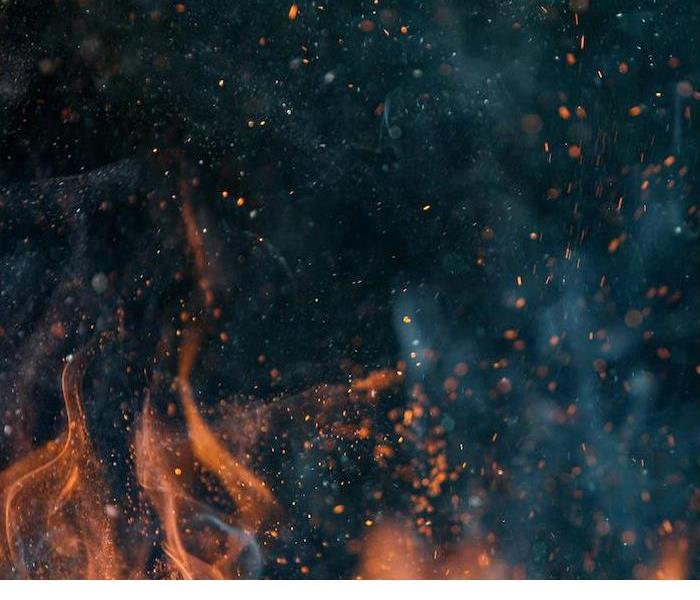 Restoring fire and smoke damage is one of our specialties. Contact SERVPRO of Pueblo to learn more.
Restoring fire and smoke damage is one of our specialties. Contact SERVPRO of Pueblo to learn more.
The warmer months offer us cookouts, seasonal celebrations and so much more. But when doing these fun things, do you focus on safety? Let’s look ahead and see what we can do in order to be proactive!
It’s a fact that the warmer months bring a higher risk of safety hazards. In fact, spring sees more daily fires on average than any other time of the year.
Do you know the risk that your home, or lifestyle, offers? Let’s take a look at the most common fire risk and what you can do to prepare:
BBQ & Cookouts
Barbecuing, cookouts, roasting marshmallows…all fun and necessary for those warmer months…but they can also be risky! Grilling provides a combination of flame, heat, grease and gas, causing it to lead to danger pretty easily. The best thing you can do before grilling is a quick check to make sure everything is in good working condition, make sure it’s away from anything flammable and be sure the grill has been cleaned. While cleaning in between uses seems to be common sense, almost 20% of grill fires are caused by improper cleaning.
Fire Pits
Fire pits, a blanket, kids and marshmallows: Every bit of that says summer! But you can become so enthralled with the beauty of the fire, along with the fun it provides, that you might let safety slip your mind. Make sure you never leave kids unattended around a fire pit, and that you always keep a bucket of water close to the pit.
Chimneys & Dryer Vents
Fireplaces are a focal point in many homes. And while fires make for great scenery as you enjoy friends and family, it is also important to make sure you get the chimney inspected every year. A buildup of ashes can cause some serious damage. In addition, your dryer vents can become clogged with lint and debris, so take the time to clean the pipes while you’re spring-cleaning.
Your local SERVPRO technicians are on hand 24⁄7 for emergencies. If you encounter fire damage at your home or business, no matter the cause, we will be there faster and have it cleaned up sooner. Call or click today and experience the SERVPRO difference.
Fire Safety Questions That Will Make Your Winter Safer | SERVPRO® of Pueblo
1/25/2021 (Permalink)
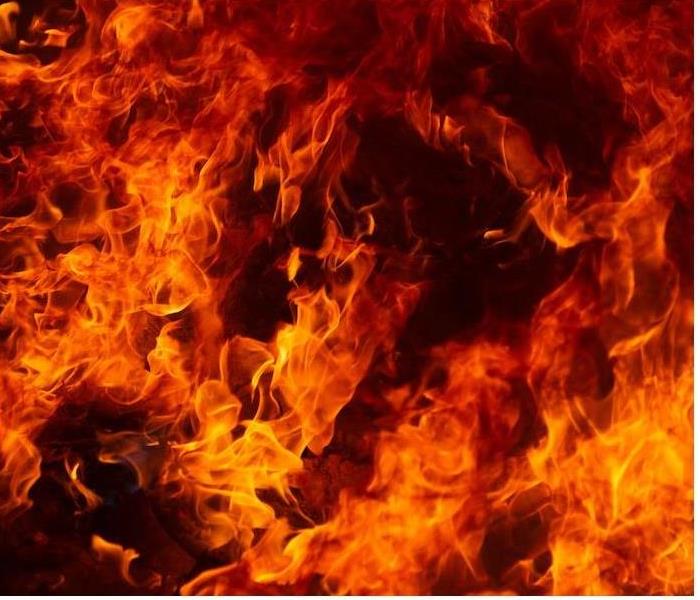 House fires trend to peak during the winter. SERVPRO of Pueblo are available 24/7 in the event of an emergency.
House fires trend to peak during the winter. SERVPRO of Pueblo are available 24/7 in the event of an emergency.
Did you know that house fires are more common during the winter months than at any other time during the year? House fires can indeed happen during any season, but they’re more common when it’s colder outside.
Experts estimate that every year about 890 Americans will die in a winter house fire. That number doesn’t include the people who will be injured or the homes and heirlooms lost to these tragic events.
Not every fire is preventable, but many winter house fires are caused by accidents and appliance failures that can be managed by taking some extra fire safety steps.
Do You Know the Answers to These Fire Safety Questions?
Your answers to these questions are a good place to start making your home safer:
Can you safely put out a grease fire? Grease fires are a common kitchen hazard, and thousands happen every year. Many people think water is the most logical way to put out a fire, but it makes grease fires worse. Instead, it would be best if you used a fire extinguisher, baking soda or a metal pan lid to smother the fire. (Cookie sheets can work, too.)
Are you cleaning the ashes out of your fireplace? Wood-burning fireplaces are a nice addition to a family living room. Use yours safely by ensuring you always have a screen covering it. Also, make sure you don’t let ashes and debris build up in your fireplace. Instead, dispose of the ashes correctly.
Are your candles in a safe spot? Many house fires every year are a result of poor candle safety. Candles may seem harmless, but they can start fires and should be used carefully. Please don’t leave them where kids or pets can knock them over. Never leave them burning when you’re not home.
If your home is damaged due to a fire or any other cause, you can always count on us for restoration assistance. We have crews who are available 24⁄7 in the event of an emergency. Contact us at any time to learn more about our restoration services and how we can help your family.





 24/7 Emergency Service
24/7 Emergency Service














